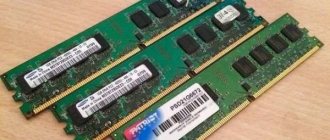Methods for determining RAM frequency in Windows 10
There are quite a lot of situations in which information about the operating frequency of RAM may be required - from banal curiosity to the need to replace RAM. There are three main ways to get the information you need. We will talk about each of them further in detail.
Method 1: Specialized software
You can find many programs on the Internet that provide the user with detailed information about each computer component. You can view the list of the most popular applications of this kind at the link below.
As an example, we will show how to find out the RAM frequency using the CPU-Z and AIDA64 programs.
CPU-Z
Despite its name, this program allows you to obtain information not only about the computer processor, but also about other components. It is distributed absolutely free of charge.
To obtain information about RAM using it, you need to do the following:
AIDA64
This program provides much more information than CPU-Z. It is paid, but has a trial period of 30 days, and this is clearly enough to find out the frequency of RAM.
To determine the RAM data transfer rate using AIDA64, you need to do the following:
Method 2: System Utility
If you are one of those users who do not like to install third-party software, then this method is for you. It allows you to find out the operating frequency of RAM through the built-in Command Line utility. You can do this as follows:
wmic memorychip get speed
Method 3: BIOS
This method is suitable only for experienced users, as it requires the use of BIOS. You can find out the operating frequency of the RAM as follows:
Thus, using any of the described methods, you can easily determine the operating frequency of the RAM of a computer or laptop. If you decide to upgrade your RAM, then we recommend that you read our dedicated guide, which contains useful tips and tricks on this topic.
Source
Let's sum it up
- If you have Windows 10, the easiest way to see the RAM frequency is in the task manager.
- If Windows 7, 8 or 10 use the command line.
- You can find out more detailed information on RAM in the program - Aida64.
- Also, all the necessary information on RAM will be shown by the CPU-Z program.
- In BIOS or UEFI you can not only find out the RAM frequency, but also increase the frequency.
- Well, the last way to look at the characteristics is to look at the RAM sticker on the sticker.
Using this information you will be able to:
- Determine the frequency of the RAM of any computer or laptop.
- Choose the right RAM to replace or increase the volume.
If you have a blue screen on your computer, then this article will help you - how to check your RAM for errors.
Each component of a computer or laptop has its own technical characteristics, and the user must be able to find out this information. From this article you will learn how to correctly determine the frequency of RAM on devices running Windows 10.
Via command line
The fastest way to find out the RAM frequency is to run a query on the command line.
The command line shows the RAM frequency
If the command produced the number 1600, then the RAM frequency is 1600 MHz. If there are several sticks of RAM installed in a computer or laptop, then there will be several values. They usually have the same frequency. Using mismatched strips will negatively impact performance, so if the values are different, we recommend replacing the mismatched strips.
What is RAM. Maximum RAM
Random access memory (RAM) is one of the most important components of a computer. It is she who decides whether your PC can handle a new game or whether it is better to immediately abandon this crazy idea. Like every computer component, RAM has its own classification and parameters. We will now try to understand its types and types.
What is RAM
Essentially, RAM is an “intermediary” between the hard drive and the processor. To ensure performance, those processes and tasks that the CPU needs to process at the moment are put into RAM. This is exactly what RAM does. The maximum RAM that can be installed on a computer will cope with these tasks many times faster.
The OP has its own characteristics. Bus frequency, volume, power consumption and much more. We will discuss all these parameters below. For now, let's move on to the types of RAM.
Types of RAM
Since time immemorial, there were such types of RAM as SIMM and DIMM. There is no point in dwelling on them now, since they have not been produced for a long time, and it has become impossible to find them. Let's start right away with DDR. The very first DDR memory was released back in 2001. It could not boast of high productivity and volume. The maximum operating frequency of the first DDR was 133 MHz. The result was not very “fast” RAM. The maximum RAM at that time was about 2 GB per stick.
With the development of technology, a new type of “RAM” has appeared. They called it DDR2. The main difference from conventional DDR was the operating frequency. Now it was 1066 MHz. A very nice performance boost. And a couple of years later, DDR3 was released - the most popular type of RAM at present. 2400 MHz is exactly the maximum frequency of RAM. There was no processor capable of supporting such frequencies at that time. Therefore, Intel and AMD had to urgently release something capable of working with such RAM.
Maximum volume
The amount of RAM plays an important role in its performance. The higher the volume of the “bar”, the more information it can accommodate. Nowadays the size of RAM is measured in gigabytes. It plays a decisive role in whether the computer can handle powerful software packages and games. But there are volume limitations on the part of the system. As an example, let's take the OS from Microsoft Windows 7. The maximum RAM that this system can work with should be 16 GB and no more. Windows 10, for example, is capable of working correctly with 128 GB of RAM. It is also worth noting that 32-bit operating systems are not capable of interacting with more than 3 GB of RAM. If your RAM is 4 GB or more, then a 64-bit OS is definitely recommended for you.
Nowadays, the optimal amount of RAM for an average computer can be called 8-16 GB. However, if you need a powerful gaming machine, then you can’t do without 32 GB of RAM. If you decide to do video editing, then you need a very large RAM. The maximum RAM should be from 32 to 128 GB. Please note that this is quite an expensive pleasure.
As for laptops, it is not possible to increase the amount of RAM indefinitely. Typically, laptops and netbooks are equipped with only two slots for RAM. Therefore, increasing the RAM is quite difficult for them. In many ways, the maximum amount of RAM in a laptop depends on the motherboard and processor used to build the laptop. Typically, motherboards are designed for 8-16 GB of RAM and there is no way to increase this limit.
RAM frequency
DDR3 RAM modules are capable of operating at frequencies of 1333-2100 MHz. To choose the best option for your computer, you need to know what frequencies are supported by the motherboard and processor. Most motherboards easily operate at frequencies of 1333-1600 MHz. If you choose a frequency of 2100 MHz, the performance increase will not be particularly noticeable given the extremely high price of the RAM and the motherboard that supports these frequencies. This is an option for really crazy gamers.
Among inexperienced users, the question often arises: “how to find out the maximum RAM.” There is an excellent program called AIDA 64. It will provide complete information about the computer's operating system. There will be a maximum frequency, volume, and type. The program provides equally comprehensive information about other computer components. Definitely, everyone should have such a product. Then many questions will disappear by themselves.
Conclusion
Now we know what RAM is, maximum RAM and its frequency. You can safely choose the OP for your computer yourself. Basic knowledge is enough to equip your PC with the most advanced RAM.
fb.ru
In BIOS
The BIOS checks all devices when you turn on the computer, so it is aware of their characteristics. Among other things, he knows the frequency of the RAM. The main problem is finding this value in the BIOS interface.
BIOS also shows RAM frequency
This is just one of the options for BIOS interfaces - and there are dozens of different versions and generations. So if you want to find out the frequency through the basic I/O system, then be prepared to search. You need to look for a parameter whose name contains the words “memory” or “frequency”.
Via BIOS
Also, certain manufacturers have developed their own labeling system - for example, Corsair. Information about the designation system can be found on the company's official website.
However, the nominal value indicated on the part does not always correspond to the actual characteristics of the RAM running in the computer: the system optimizes its operation based on a number of other parameters. The frequency is prescribed (and also regulated) in the BIOS. This method is suitable if Windows does not boot.
To enter the BIOS, you need to press a certain key during reboot (usually Del or F2, although exceptions are possible). The menu depends on the manufacturer and version of the BIOS itself.
Most often, the memory frequency is designated Memory Frequency, Memory Clock, DRAM Frequency or DRAM Clock. If the parameter is specified as the ratio of the system bus frequency to the memory frequency, it is called Ratio.
And if at the same time you decide to set the frequency higher, keep in mind that the power consumption of the computer and the temperature of the module itself will increase. Unstable operation or part failure is also possible.
The above method is the same in both laptop and desktop PC.
It is also worth noting that laptop manufacturers often assign non-standard keys to call the BIOS. Which ones you can find out from the accompanying documentation or on the official website.
Using third party utilities
In the article about the best programs for diagnosing a laptop, we talked about utilities for system monitoring. They collect a huge amount of information about devices and Windows. Using such programs, you can easily find out the frequency of RAM and other characteristics of RAM.
Speccy
Speccy is a free monitoring utility. Once launched, it displays general information about the system. Among other information, we see the frequency of the RAM. An important clarification is the bus frequency. To find out the data transfer speed, you need to multiply the value by 2.
Speccy shows detailed RAM specs
You can find out a little more information about RAM on the “RAM” tab. It shows the type, volume, number of channels, frequency, load percentage and other characteristics.
CPU-Z is another free program for diagnosing laptops and PCs. Launch it and go to the “SPD” tab. Here you need to select “Slot #1” and look at the value of the “Max Bandwidth” line. CPU-Z also shows the bus frequency. To evaluate performance, multiply the resulting value by 2.
RAM frequency
Information about RAM is also available on the “Memory” tab. It displays general information about the memory capacity and frequency.
AIDA64
AIDA64 is a powerful program for monitoring the status of laptops and computers. A license is required for permanent operation, but the utility can be used for free for 30 days. AIDA64 shows noticeably more RAM information than Speccy or CPU-Z. Frequency is also included in this information.
In this case, the actual RAM frequency is 800 MHz, and the effective frequency is 1600 MHz.
Real and effective memory frequency in AIDA64
These are just a few monitoring programs that show the frequency and other characteristics of RAM. You can use other utilities - they all work on approximately the same principle, automatically collecting information about the computer and system.
Source
We look at the inscription on the memory
This parameter can be determined directly by the markings on the bar itself.
To do this, you will first need to remove the cover of the system unit and carefully remove one of the strips from a special slot on the motherboard. Unfasten the latches that prevent accidental disconnection and remove the connector module.
To find out all the information about the RAM module, you need to carefully examine it. The bar indicates the name of the module, the type of RAM and the peak data transfer rate.
Using this data, you can find out the memory frequency in special correspondence tables. We present them for various types of RAM. The notes indicate how popular they are currently.
As we can see, in our example, for the PC2 module – 6400, the bus frequency is 400 MHz, 800 million operations/sec, 6400 MB/s or 6.4 GB/s – peak data transfer speed.
How to make an oscilloscope from your computer
And the last currently existing standard, characterized by increased frequency characteristics and lower supply voltage.
How to find out the RAM frequency of Windows 10
The main parameter of RAM is its operating frequency. To find out this characteristic in Windows 10, the old methods are not so convenient, and many are wondering how to check the speed and determine the size and type of RAM. Follow this troubleshooting guide and try one of the methods below.
Although many turn to third-party software, this is not necessary these days. Of course, in this case you will get a little more information, but this is not often needed. We'll show you how to do this using several built-in tools.
How to understand what kind of “beast” a store offers
- DDR3, 12800 Mb/s.
- DDR3, PC12800.
- DDR3, 800 MHz (1600 MHz).
- DDR3, 1600 MHz.
Some might think that in this example we are talking about four different planks. In fact, this can be used to describe the same RAM module with an effective frequency of 1600 MHz! And all these numbers indirectly or directly point to it.
To avoid any further confusion, let’s figure out what they mean:
- 12800 MB/s is the memory bandwidth, an indicator obtained by multiplying the effective frequency (1600 MHz) by the bus width of one channel (64 bits or 8 bytes). Bandwidth describes the maximum amount of information that a RAM module is capable of transmitting in one clock cycle. I think it’s clear how to determine the effective frequency from it: you need to divide 12800 by 8.
- PC12800 or PC3-12800 is another designation for the bandwidth of a RAM module. By the way, a set of two strips intended for use in dual-channel mode has 2 times higher bandwidth, so its label may indicate PC25600 or PC3-25600.
- 800 MHz (1600 MHz) – two values, the first of which indicates the frequency of the memory bus itself, and the second - 2 times higher - its effective frequency. How are the indicators different? Computers, as you know, use DDR type RAM - with double the data transfer rate without increasing the number of bus cycles, that is, in 1 clock cycle not one, but two conventional pieces of information are transmitted through it. Therefore, the main indicator is considered to be the effective clock frequency (in this example, 1600 MHz).
CPU-Z application
This is a free application that provides statistics on the main components of your computer. This amazing tool offers information about the processor (code name cache levels, number and package), motherboard, chipset and RAM type [module size and specification]. Install the utility from here: https://www.softportal.com/get-1504-cpu-z.html
Launch the program and go to the Memory tab in Control Panel.
All the necessary data will be presented here.
How to find out the frequency of RAM in Windows
First, I’ll show you how to find out the frequency of RAM using Windows 10 and through the command line.
Method 1: Windows 10 Task Manager
To determine the RAM frequency in Windows 10, you need to open the task manager.
Press the Ctrl+Shift+Esc as shown below.
Hot keys ctrl+shift+esc
Open the Performance - Memory . The RAM frequency will be indicated in the lower right corner - for example, a speed of 800 MHz.
Windows 10 Task Manager - RAM frequency 800 MHz
Join the VK group - https://vk.com/ruslankomp I will help you solve the problem with your PC or laptop.
Method 2: CMD Command Line
Regardless of the Windows version, you can find out the RAM frequency through the command line.
To open the command prompt, press Win+R simultaneously.
Hotkeys Win+R
Type cmd and press Enter .
CMD - launch command line
To show the current RAM frequency, type the command and press Enter:
Below the Speed
The frequency of the RAM sticks will be indicated.
RAM frequency in the command line
To find out the location of the RAM sticks by slot, enter the command:
and press Enter to apply.
Clue! To avoid typing the command manually, copy the command and paste it into the command line by right-clicking - paste. Press Enter.
Copy the command and paste it into the command line with the right mouse button
In the same way, you can find out other RAM parameters by entering the following commands:
How to view RAM on Windows 10
There are several ways to view RAM in Windows Which one to choose is up to you. In any case, they are all quite simple. Let's take a closer look.
Checking with built-in system tools
The option does not involve the use of third-party software or intervention in the system unit. To view the amount of RAM, you can use one of two methods.
Method #1:
- On the desktop, right-click on the “My Computer” shortcut.
- Select “Properties” from the drop-down menu.
In the “System” , find the line “Installed RAM”. The installed amount of RAM will be indicated next to it.
Method #2:
- Press the combination Win+R on your keyboard.
- In the “Run” , enter the command “msinfo32” and press Enter.
By default, the “System Information” section opens. In it you need to find the line “Installed random access memory (RAM)” , this will be the information you are looking for. You can also find out the amount of available RAM, the size of the paging file, etc. nearby.
note
- How to check the RAM of a computer or laptop
The described technique does not allow you to find out the type of RAM. It will also not be possible to find out the full volume if it exceeds 3 GB and 32-bit Windows is installed on the computer; only 3 GB will be shown, even if, for example, 8 GB is installed on the motherboard. The larger amount of memory is only displayed on the 64-bit version of the operating system.
How to check RAM frequency with a program
To determine the frequency of RAM we will use the following programs:
Method 3: AIDA64
Download AIDA64 from this link.
In AIDA64, the RAM frequency can be viewed in another way.
If you overclocked the frequency, you can see the actual frequency in the Benchmark test.
The actual frequency will be indicated in the Memory Bus field - 665.3 MHz. This value must be multiplied by 2 to obtain the correct result.
Real RAM frequency 665.3*2=1330.6 MHz
To see the real and effective frequency of RAM in AIDA64 you need to go.
Method 5: RAM frequency in BIOS or UEFI
To enter the computer's BIOS, you need to press the Delete key at rapid intervals when turning it on. On a laptop, press F2.
After the BIOS or UEFI opens, depending on the motherboard, look for the item with the word Memory.
RAM frequency in BIOS - 2133 MHz
Here's how to check the memory frequency in an ASUS motherboard with UEFI.
RAM frequency in UEFI - 1800 MHz
Where is the RAM frequency indicated in Windows 10?
It is no secret to many that the clock speed of RAM affects the overall performance of the computer. The higher it is, the faster the data is exchanged and the faster the assigned tasks are completed. In heavy and resource-intensive applications, low RAM speed can even lead to stuttering and stuttering. This is especially true for modern 3D games, which require quickly moving large amounts of data between the processor and RAM.
In this regard, some users are asking the question: where in Windows 10 can you see at what frequency the RAM is currently running? You will find out the answer from this article.
Descriptions of RAM modules
- FPM . This module was used on computers with the 485 processor in 1995. Has dynamic memory.
- EDO . The EDO module is a variant of an improved FPM assembly. Introduced in 1995 for computers with a Pentium processor.
- RAMBUS (RIMM) . This type of memory appeared in 1999. The module receives data in small portions, but at a high clock frequency. Intel faced enormous challenges in implementing the module. It did not become successful in the market.
- SDRAM . Random access memory. The module appeared in 1998 and was used until 2001. The overall cycle time was reduced, resulting in higher memory performance than its predecessors.
- DDR . The module appeared in 2001. It differs from SDRAM in that the module transmits data twice per clock cycle instead of doubling the clock frequency. At the moment it can still be found on the market.
- DDR2 . The second improved version of DDR appeared in 2003. The DDR2 module is almost twice as fast as DDR. But the performance when working with memory was slowed down.
- DDR3 . Energy consumption decreased by 40% and speed doubled.
- DDR4 . The bus can reach speeds of 2 Gbit/s. DDR3 supports lower power consumption compared to DDR3. This affects productivity growth by up to 50%.
| Memory module | Frequency, MHz |
| FPM | 22 |
| EDO | 33 |
| RAMBUS (RIMM) | 600 |
| SRAM | 166-200 |
| DDR | 200-400 |
| DDR2 | 533-1200 |
| DDR3 | 800-2400 |
| DDR4 | 1600-3200 |











